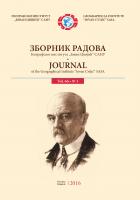Exposure To Earthquakes — Distribution And Change Of The World’s Population With Regard To Disposition Of Seismic Activities
Exposure To Earthquakes — Distribution And Change Of The World’s Population With Regard To Disposition Of Seismic Activities
Author(s): Ivan Filipović, Ranko Dragović, Aleksandar Radivojević, Milan ĐorđevićSubject(s): Human Geography, Environmental Geography, Transformation Period (1990 - 2010), Present Times (2010 - today)
Published by: Географски институт »Јован Цвијић« САНУ
Keywords: earthquake intensity zones; population; vulnerability; developing countries;
Summary/Abstract: Earthquake effects can be distinctly different in two different countries even if the earthquake has the same level of intensity. Loss and damage caused by the earthquake will be much less in developed countries than in developing countries. Due to its inability to prevent and cope with disasters developing countries are in the focus in this article. This paper presents an approach for detecting the most and the least vulnerable countries of the world and the distribution of their population within different earthquake intensity zones. There is also a summary of the change in world population during the 25-year period (1990–2015), within continents and earthquake intensity zones as well as a comparison between continents. The population growth is unevenly distributed and highest in the zone with probable maximum intensity VIII. In relation to the World population by earthquake intensity zones, the developing countries have the lowest share of its population among the zone with most destructive earthquakes.
Journal: Зборник радова Географског института "Јован Цвијић" САНУ
- Issue Year: 66/2016
- Issue No: 3
- Page Range: 353-370
- Page Count: 18
- Language: English

